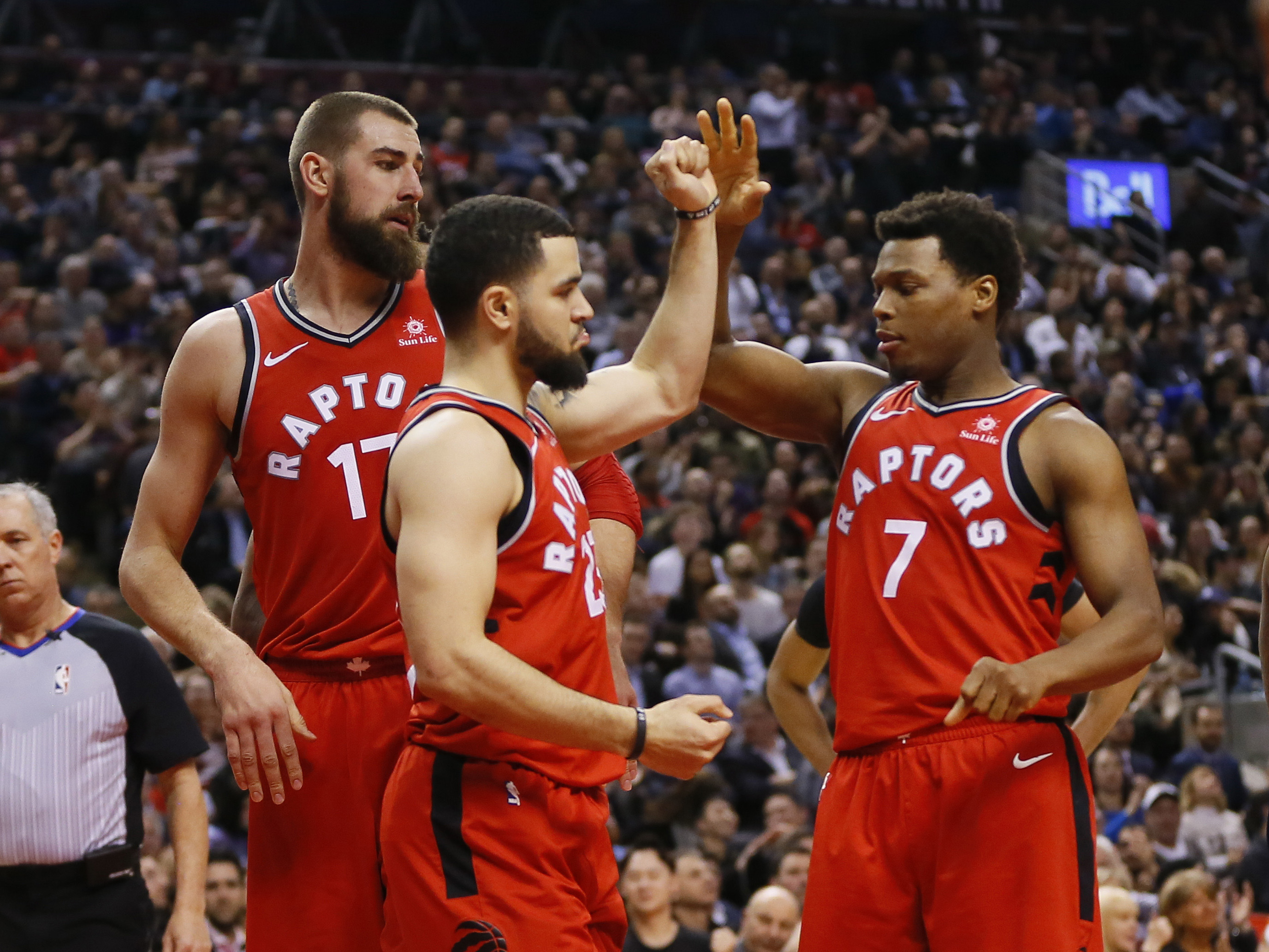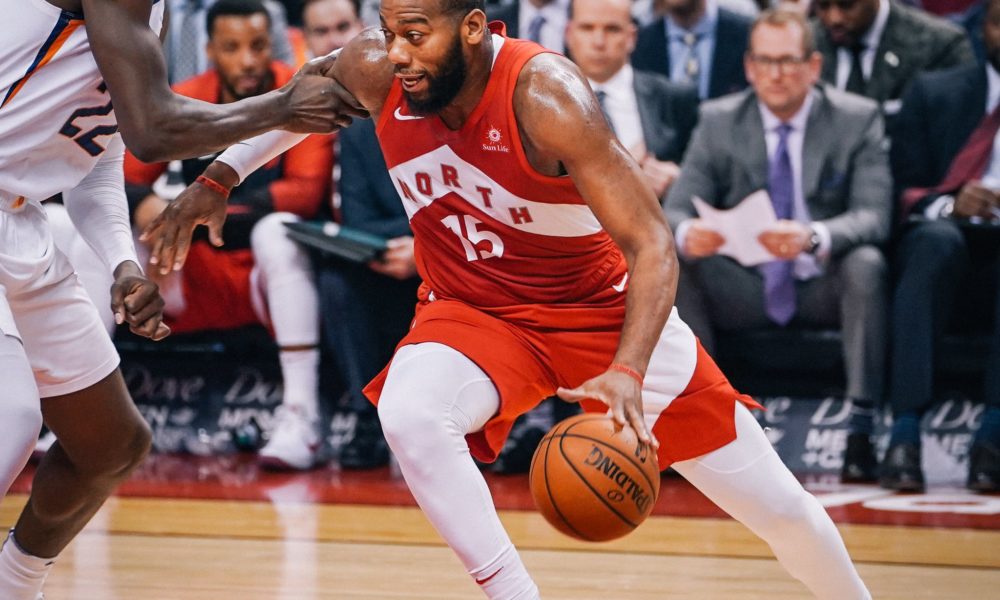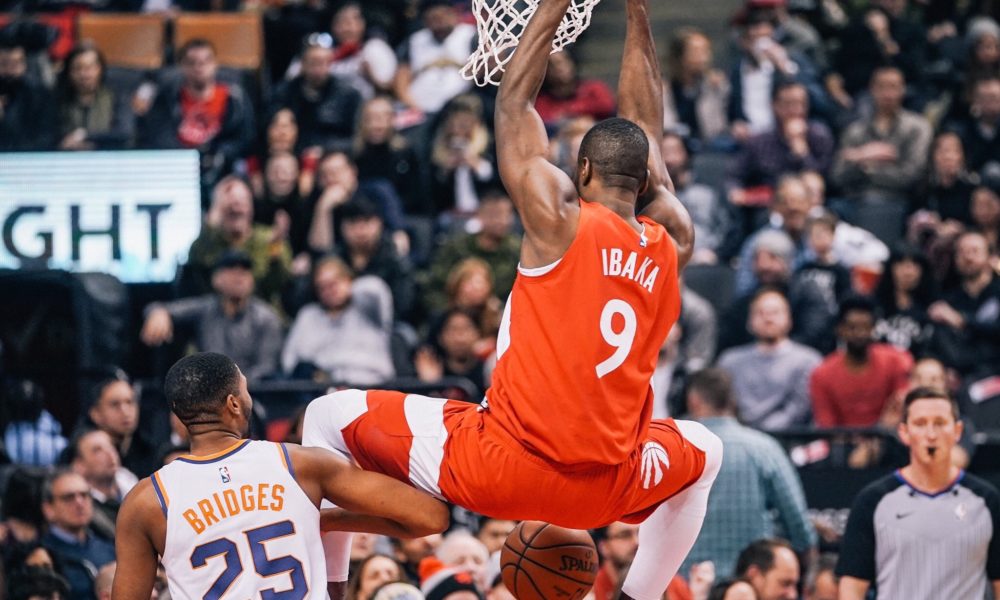Injuries have hit the Toronto Raptors hard this season. For weeks, the Raptors played without a variety of rotation players. Kyle Lowry and Kawhi Leonard didn’t play in a game together between December 10 and January 7. Jonas Valanciunas has been on the shelf for what seems like an eternity. Over the past month, the Raptors had to do anything to succeed. Instead of working on chemistry and tinkering with rotation questions, the Raptors found themselves playing with their backs in the corner. However, those days seem to be coming to an end. Other than Valanciunas, most Raptors are now healthy, and other than a miserable closing stretch against the Boston Celtics, the team is playing well. However, over such a long stretch fighting injury, the Raptors have learned valuable lessons about the present value of Valanciunas and the future value of Fred Van Vleet.
The Raptors have learned an important lesson with Valanciunas out of the lineup: they need the big guy, and it’s because of his defensive utility. That’s an important lesson to learn, as Valanciunas hasn’t missed a hefty chunk of time since the 2015-16 season, when he missed 17 games with a fracture in his left hand. The team and league has changed dramatically since then, and the Raptors finally got a look at themselves without Valanciunas’ bulky presence on the inside.
The whole puzzle just doesn’t look as tight-fitting with Valanciunas gone. Before his injury on December 12, the Raptors’ offensive rating was 113.2 and defensive rating was 105.3, with a 76.7 winning percentage. Since his injury, those numbers have flattened to 109.2 and 109.1. Despite their 0.1 net rating, they have managed an 12-6 record (66.7 winning percentage) due to Leonard’s clutch heroics, among other factors.
Of course, there have been other injuries alongside Valanciunas’ that have contributed to the flat-lining of the Raptors’ performance, but the big man has been greatly missed. No one on the team combines his size and rim deterrence.
Ibaka has had a resurgent year, but there are matchups in which he struggles. Against monster centers like Hassan Whiteside or Nikola Vucevic, Ibaka is not the team’s best option. (Despite his best efforts, Greg Monroe hasn’t had a pulse on the defensive end all year.) In two games in late December against the Miami Heat and Orlando Magic, the Toronto Raptors went 1-1 with a -27-point differential. Whiteside and Vucevic combined for 46 points and 31 rebounds. Both sported game-high plus-minuses; Whiteside at +22 in a game his team lost by 2, and Vucevic at +33 in a game his team won by 29. They combined to shoot 18-for-23 at the rim.
The Raptors need Valanciunas as a defensive option in contexts like those. He isn’t the shot-blocking presence of Ibaka, but he is better at forcing misses around the rim. Per nba.com’s tracking stats, Valanciunas holds opponents 16.1 percent below their averages when shooting at the rim with Valanciunas in the vicinity, compared to Ibaka’s still-great 11.0 percent. (Valanciunas actually leads the league in forcing misses at the rim among rotation players). Those numbers have plenty of flaws, especially in comparing year-to-year data, but they still say something valuable about Valanciunas in comparison to the team’s other options at the position.
Valanciunas is the Raptors’ best option at defending a behemoth and still cleaning the defensive glass.
On top of his size, he’s more mobile than in past years, and he’s benefited from an increased focus on verticality. His strength means he can contest shots with his body, purely by dislodging opponents’ centers of gravity.
Partially as a result of his success (and partially as a result of other, less controllable variables), Valanciunas sports the team’s lowest defensive rating among rotation players, at 101.3. That might not mean much, but definitely doesn’t mean nothing. When Valanciunas is on the court, opponents shoot 6.2 percent more shots from midrange, and 5.1 percent less at the rim; he doesn’t just defend shots well around the rim, but he also prevents them from even occurring.
Valancunias remains a context-specific player, but there are many contexts in which he is a necessity. I’ve only discussed his defensive utility, but there is no other offensive player on the roster who can imitate his value, either. Valanciunas is the team’s best screen-setter, roller, interior finisher, and offensive rebounder. (Still, the Raptors can still sport an elite offence with either of Ibaka or Valanciunas at center.) Valanciunas’ offensive skills remain valuable across the board in any context, especially in his pre-injury time-share with Ibaka. He is a far superior option to Monroe in filling any non-Ibaka center minutes, especially on bench units that require higher efficiency than Monroe’s 54.4 percent shooting at the rim. He can also boost the starters’ offence when his defence is required there.
Valanciunas’ offence has become a luxury on an elite offensive team. Despite his reputation as an offence-only player, his defence is what the team has truly missed. Valanciunas may not be the player the Raptors want manning the center in the finals against Draymond Green, but he will be vital for the Raptors’ chances of getting there. It’s impressive that the Raptors have gone from shopping Valanciunas to anxiously awaiting his return in just the span of a few seasons.
So, it’s established that Valanciunas is important to the team’s present. But the Raptors have also learned valuable lessons about their future, namely, that Van Vleet is on track to develop into the team’s starting point guard. The Raptors have big expectations for his development going forward.
“I think all those guys, guys like in Fred’s situation, there’s kind of these levels. You’re an NBA player, you’re a rotational player, you’re a backup, you’re a starter. Are you good enough to be a starter in this league for five, six, seven years? I think that’s what Fred’s mindset’s gotta be, can he be a guy that can start in this league, do it every night and play consistently,” coach Nick Nurse said before Lowry returned against the Indiana Pacers. “The guys that are putting up 25 points a night in that elite air, its unbelievable that they can do that. Every night and fly and play and fly and play and double header they just keeping putting 25 points up and that’s the rare air those guys get into. I think that’s a level Fred has to aspire to and he is aspiring to and I think he certainly is good enough to be a starter in this league. He runs the team, he defends, he shoots it, he’s got some uncanny abilities, he’s the late shot clock maker, he’s a big shot maker, he’s a late game shot maker. Those things are special things.”
Certainly, he isn’t there yet. He has struggled throughout the season to handle in the pick-and-roll, though that has improved recently, in fits and starts. To be fair, Van Vleet was recently smothered by the Boston Celtics’ length. However, Van Vleet is at his best when surrounded by better players, not when he’s the focal point of the bench offence. Alongside mediocre talent against Boston, Van Vleet looked quite bad on the drive.
But alongside Toronto’s top players, those same plays were productive for Van Vleet.
Peep his general numbers as a starter versus his numbers as a reserve.
| Minutes per game | Points per game | Assists per game | Turnovers per game | 3-point shooting percentage | |
|---|---|---|---|---|---|
| As a starter | 32.5 | 12.8 | 5.3 | 1.3 | 39.3 |
| As a reserve | 22.6 | 8.5 | 3.9 | 1.3 | 33.7 |
Van Vleet is much better off the ball than on it, which is not a great quality for a point guard. Still, he’s flat-out dominated alongside more ball-dominant players like Pascal Siakam and Kawhi Leonard. While Lowry was injured, the team’s natural starting lineup was Van Vleet-Danny Green-Leonard-Siakam-Ibaka. Van Vleet spat hot fire in those rotations. Per pbpstats, his per 100 possession averages were 23.1 points (on, uh, 74.5 percent eFG and 59.3 percent from deep), 8.5 assists, and 5.1 rebounds. The team has had a plus-minus of 18.3.
Alongside the same other four starters, and also per 100 possessions, Lowry has averaged 11.4 points, 14.1 assists, and 4.2 rebounds. The team has had a plus-minus of 11.0. Van Vleet and Lowry are not the same player, clearly, but Van Vleet has thrived in the same situations where Lowry has also thrived. Van Vleet is good enough now to dominate alongside equal or better talent than his own. He is not yet good enough to lift bench lineups into wrecking machines, which has been Lowry’s calling card (among others) for years. Can Van Vleet get there? And why don’t his skills translate as well to the bench lineup this year?
Much of what makes Van Vleet so effective as a point guard with the starting group is because it emphasizes his strengths and hides his limitations as a passer. He is solid at finding a popping big – ie, Ibaka – and still learning how to develop chemistry with a roll man: ie, Jonas Valanciunas.
Van Vleet doesn’t have many advanced reads in his bag yet, but he is comfortable hitting the release valve on the pick-and-roll as well, which is frequently provided by a shooter on the weakside wing.
Adding comfort with more passing reads will take some learning, but there’s a framework there upon which Van Vleet can build. Learning how to significantly bend the defence with his dribble and make more advanced passes out of the pick-and-roll will come with time and trust. When he improves his passing chops, he will be far more effective on bench lineups.
Van Vleet is an elite shooter, although the discrepancy between his catch and shoot 3-point percentage (40.4 percent) and his pull-up 3-point percentage (31.0) is concerning. Elite point guards today need to be almost as strong shooting pull-ups as shooting off the catch. Steph Curry (45.9 to 43.6), James Harden (28.6 (!) to 38.1), Kyrie Irving (41.5 to 38.9) and Damian Lillard (39.1 to 37.6) all display only a slight drop-off (or massive increase, in the case of Harden) from their catch and shoot to pull-up numbers. Van Vleet can get there, and he shows the skill from time to time.
Van Vleet is already a terrific defender, and he’s at his best scampering around screens and hampering shooters. He’s got the classic scamper-and-hamper down pat. He’s a two-way player, which is a necessity for starting-caliber guards on winning teams.
Overall, Van Vleet is already much of the way there towards being a starting-caliber point guard for the Raptors. In Lowry’s absence from December 26 to January 5, the Raptors went a solid 4-2, with wins over the Utah Jazz and Milwaukee Bucks. In those wins, Van Vleet compiled 13 assists compared to 2 turnovers. High level contributions from Van Vleet aren’t a foregone conclusion every night, but consistency comes with more reps. He needs to develop a variety of skills, including interior passing, ball-handling, finishing, and pull-up shooting, but the arc of his career makes it more likely that he does develop those skills than the opposite.
The Toronto Raptors need Kyle Lowry to reach their peak this year, as he completely changes the look and feel of the offence. With Lowry at the helm, there’s more passing, faster movement, and sharper action. That likely won’t be true in future years. Van Vleet is comfortable off the ball, and he’s improving on the ball. He took leaps forward during his time as a starter. Signs point towards him being able to take up the mantle when Lowry’s contract expires. With a few more years of seasoning and learning, Van Vleet should be ready; the Raptors expect big development from him going forward.
The Raptors have struggled through a definite malaise over the past month that has seen their player availability dip alongside their winning percentage. It’s incredible that they continue to lead the league in wins. It’s all the more important, then, that the Raptors were able to learn valuable lessons about the present and future during their period of relative struggle.



